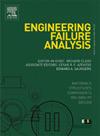Strength assessment of composite beams under combined loads for application in mechanical suspension systems
IF 4.4
2区 工程技术
Q1 ENGINEERING, MECHANICAL
引用次数: 0
Abstract
Composite materials are currently an essential resource for the development of lightweight components in the automotive industry. High strength-to-weight ratio and corrosion resistance make composites a good alternative to traditional materials, such as in mechanical suspension systems, where the design of composite leaf springs has been the focus of recent studies. This paper aims to propose a structural concept for a composite leaf spring for heavy vehicles, which should resist the severe stresses caused by poor road conditions, maintaining the stiffness characteristics required for the design, allowing reduction in composite mass, and offering means to dissipate the energy absorbed by the suspension system. Considering rough road applications, suspension springs are commonly subjected to flexural–torsional forces, which justifies the search for a spring concept with increased resistance to these two types of forces. The concept of a sandwich beam with external layers of composite material and a core of more flexible material is explored in the paper. When the fibers of the composite are oriented longitudinally, the sandwich beam can benefit from the high strength of the composite in this direction when subjected to the non-uniform torsion phenomenon. Finite element models are used to obtain failure loads of different concepts of composite beams, and interaction diagrams are plotted considering different combinations of flexural and torsional loads. A representative model of a suspension spring is considered, where simplified geometric constraints are assigned to analyze the structural performance of the sandwich spring concept. Finally, the potential application of a sandwich spring is discussed.
机械悬挂系统中组合荷载作用下组合梁的强度评定
复合材料是目前汽车工业发展轻量化部件的重要资源。高强度重量比和耐腐蚀性使复合材料成为传统材料的良好替代品,例如在机械悬架系统中,复合钢板弹簧的设计一直是最近研究的重点。本文旨在提出一种用于重型车辆的复合钢板弹簧的结构概念,该结构应能够抵抗恶劣路况造成的严重应力,保持设计所需的刚度特性,允许减少复合材料质量,并提供消散悬挂系统吸收的能量的手段。考虑到粗糙的道路应用,悬架弹簧通常会受到弯曲-扭转力的影响,这证明了对这两种力的阻力增加的弹簧概念的研究是合理的。本文提出了一种以复合材料为外层,以柔性材料为核心的夹层梁的概念。当复合材料纤维纵向取向时,夹层梁在遭受非均匀扭转现象时可受益于该方向复合材料的高强度。采用有限元模型计算了不同概念组合梁的破坏荷载,并绘制了考虑不同弯扭荷载组合的相互作用图。考虑了一个典型的悬架弹簧模型,通过简化几何约束来分析夹层弹簧概念的结构性能。最后,讨论了夹层弹簧的潜在应用。
本文章由计算机程序翻译,如有差异,请以英文原文为准。
求助全文
约1分钟内获得全文
求助全文
来源期刊

Engineering Failure Analysis
工程技术-材料科学:表征与测试
CiteScore
7.70
自引率
20.00%
发文量
956
审稿时长
47 days
期刊介绍:
Engineering Failure Analysis publishes research papers describing the analysis of engineering failures and related studies.
Papers relating to the structure, properties and behaviour of engineering materials are encouraged, particularly those which also involve the detailed application of materials parameters to problems in engineering structures, components and design. In addition to the area of materials engineering, the interacting fields of mechanical, manufacturing, aeronautical, civil, chemical, corrosion and design engineering are considered relevant. Activity should be directed at analysing engineering failures and carrying out research to help reduce the incidences of failures and to extend the operating horizons of engineering materials.
Emphasis is placed on the mechanical properties of materials and their behaviour when influenced by structure, process and environment. Metallic, polymeric, ceramic and natural materials are all included and the application of these materials to real engineering situations should be emphasised. The use of a case-study based approach is also encouraged.
Engineering Failure Analysis provides essential reference material and critical feedback into the design process thereby contributing to the prevention of engineering failures in the future. All submissions will be subject to peer review from leading experts in the field.
 求助内容:
求助内容: 应助结果提醒方式:
应助结果提醒方式:


